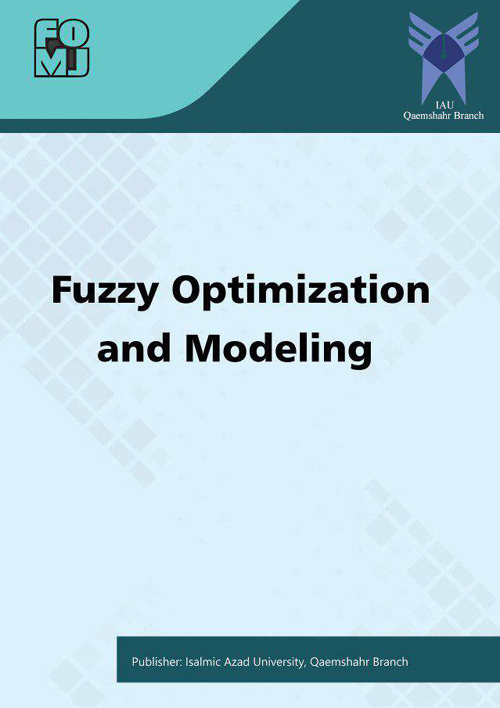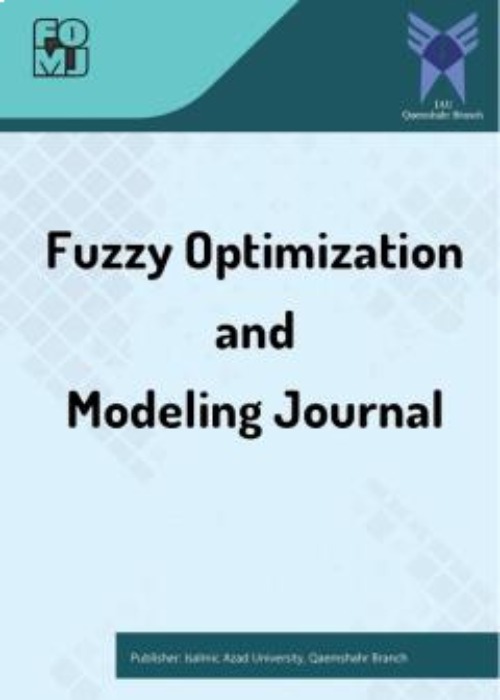فهرست مطالب

Fuzzy Optimzation and Modeling
Volume:3 Issue: 2, Spring 2022
- تاریخ انتشار: 1401/05/29
- تعداد عناوین: 6
-
-
Pages 1-18
Portfolio construction and achieving the set of securities with the most desirability is one of the most critical problems in financial markets. Generally, there are two types of financial problems in literature, choosing the right stock portfolio from a set of possible options which is called portfolio selection, and calculating the portion of the purchase for each option which is called Portfolio optimization. In this paper, a new two-phase robust portfolio selection and optimization approach is proposed to deal with the uncertainty of the data. In the first phase of this approach, all candidate stocks’ efficiency is measured using a data envelopment analysis (DEA) method. Financial criteria for evaluation chosen from fundamental perspectives. Then in the second phase, by applying the Fuzzy Weighted Goal programming (FWGP) model with criteria related to modern portfolio theory (return and risk) as well as the mentioned criteria, the portion of investment in each qualified stock is determined and the optimal investment portfolio is formed. Finally, the proposed approach is implemented in a real case study of the Dow Jones Industrial Market (DJIA). The resulting portfolios for the proposed models are compared against each other as well as against the Dow Jones Industrial Average index. The results show that for the data used and factors investigated some of the constructed portfolios, with a much smaller number of constituents, could potentially outperform DJIA in terms of their performance.
Keywords: Portfolio optimization, Fundamental Analysis, goal programming, Fuzzy uncertainty, Data envelopment analysis -
Pages 19-26
In an effort to make modification on the classical Hestenes--Stiefel method, Shengwei et al. proposed an efficient conjugate gradient method which possesses the sufficient descent condition when the line search fulfills the strong Wolfe conditions (by restricting the line search parameters). Here, we develop a three--term extension of the method which guarantees the sufficient descent condition independent to the line search. Also, we establish global convergence of the method using convexity assumption. At last, practical merits of the proposed method are investigated by numerical experiments on a set of CUTEr test functions. The results show numerical efficiency of the method.
Keywords: Unconstrained optimization, Conjugate gradient method, sufficient descent condition, Global convergence -
Pages 27-42
The rational interpolation sometimes gives better approximations than polynomial interpolation particularly for large sequence of points. In this paper, for the first time we provide a combination of rational interpolation and interval data. we present applied interval arithmetic in rational interpolation, when support points are interval-valued. First, we introduce the basic concepts of the algebraic theories to apply the interval methods to uncertainty analysis. Then the interpolation of interval coefficient is obtained and also the error of the proposed method is analyzed and is proved by a theorem for different cases. Some different numerical examples are given to illustrate the proposed method and the results are recorded.
Keywords: Interval value, Rational interpolation, Interval arithmetic, Rational function -
Pages 43-48
Let G be a graph of order n and with the vertex set {v_1,v_2,…,v_n } and the edge set E(G). The adjancency matrix of G is an n×n matrix A(G) whose (i,j)-entry is 1 if v_i is adjacent to v_j and 0, otherwise. Assume that D(G) is the n×n diagonal matrix whose (i,i)-entry is the degree of v_i. The matrices L(G) = D(G) - A(G) and Q(G) = D(G) + A(G) are called the Laplacian matrix and signless Laplacian matrix of G, respectively. The signelss Laplacian eigenvalues of a graph are the roots of characteristic polynomial of the signless Laplacian matrix of it. In this paper, we obtained signless Laplacian spectrum of some special subgraphs of complete graph and then estimated some bounds for signless Laplacian Energy of some graphs.
Keywords: Signless Laplacian Spectrum, Signless Laplacian Energy, Signless Laplacian Eigenvalues, Graph -
Pages 46-51
In present paper, the stability of generalized Jordan derivations associated with Hochschild 2-cocycles of triangular algebras for the generalized kind of Jensen-type functional equation is investigated. In fact, the main purpose of present paper is to prove the generalized Hyers-Ulam-Rassias stability of generalized Jordan derivation between algebra ${mathcal A}$ and an ${mathcal A}$-bimodule ${mathcal M}$. In present paper, the stability of generalized Jordan derivations associated with Hochschild 2-cocycles of triangular algebras for the generalized kind of Jensen-type functional equation is investigated. In fact, the main purpose of present paper is to prove the generalized Hyers-Ulam-Rassias stability of generalized Jordan derivation between algebra ${mathcal A}$ and an ${mathcal A}$-bimodule ${mathcal M}$.
* The formulas are not displayed correctly.
Keywords: Generalized Jordan Derivations, Jensen-type, Stability -
Pages 51-61
A good idea for a decision maker to protect and increase the efficiency of the decision-making units (DMUs) in an organization, is to allocate the fixed costs between them based on their efficiencies. Since, data envelopment analysis (DEA) is a suitable method to calculate the efficiency, allocating fixed costs to DMUs based on the two-stage network DEA (NDEA) approach is done by researchers. But due to some limitations (like producing a product in several steps, receiving incomes in several stages and etc) and some organization necessities, it is impossible to do this allocation just in two-stages. In this paper, we suggest a model for allocating the fixed cost among DMUs in more than two-stage network DEA approach, so that more than allocating the fixed cost, increasing in efficiency is also considered. Also, a benchmark example in reality is presented to illustrate the model and its applications.
Keywords: Data envelopment analysis, Efficiency, Multi-stage NDEA allocation, Fixed costs


